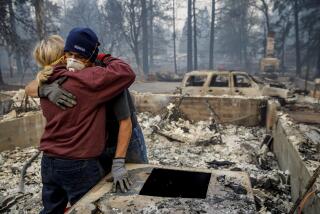Kids rejoiced when school reopened. Then fire left many students homeless
When Happy Camp Elementary School in rural Northern California started class two weeks ago, it was one of the few in California to reopen classrooms for children during the COVID-19 pandemic.
Abigail Yeager had worried at first whether sending her 6- and 8-year-old sons was the safe thing to do and whether wearing masks “was going to freak them out.”
Those fears were quickly relieved. Her sons and other students were thrilled to be back in school, and it seemed like a major victory in Happy Camp, a Siskiyou County town of 800 people along the Klamath River.
But this week, the Slater fire devastated Happy Camp, destroying 150 homes and killing two people. Half of the elementary school staff lost their homes, and administrators estimate that half of the 109 students are now homeless.
“It was going so well,” said Yeager, a member of the Happy Camp Union Elementary School District Board of Trustees. “It was doing so much for our kids, and it’s been ripped away again. I was trying to process all of the loss, and there’s another loss — the normalcy for the kids. It’s just chaos.”
Yeager considers herself lucky. She did not lose her home. But Happy Camp remains evacuated as the completely uncontained blaze rages on, and the losses are staggering in the isolated, impoverished town 13 miles south of the Oregon border.
One of the things that residents fear most of all is that their tragedy will be overlooked as the West Coast is besieged by some of the largest wildfires in modern history.
“We need help. We need to rebuild our community. We are strong, but we’re definitely not Orange County or the Bay Area,” said Judy Hahn, president of the elementary school board, who slept for several nights this week in her car with her dog and her husband’s urn because her home was under evacuation orders.
“We’re small. But I don’t want to be swallowed up and forgotten.”
The Slater fire, which began Monday night in the Klamath National Forest, had burned 136,314 acres as of Friday evening with zero containment.
The wind-driven blaze exploded in size Wednesday night, growing from 30,000 acres to more than 120,000 and crossing the border into Oregon, a state already grappling with its own massive wildfires, with half a million people under evacuation orders.
On Friday, the Slater fire was chewing through three national forests: the Klamath, the Six Rivers and the Rogue River-Siskiyou.
Two bodies were recovered this week in the Happy Camp area, said Lt. Jeremiah LaRue, a spokesman for the Siskiyou County Sheriff’s Office. They have not been identified. Authorities, LaRue said, were trying to find 10 people whose whereabouts were unknown.
The vast, heavily forested region is sparsely populated, with steep terrain and few roads, said Duane Lyon, a spokesman for the multiagency team fighting the blaze. That has made it difficult to get firefighting personnel and equipment.
“There’s a strong competition for resources throughout the whole United States,” Lyon said. Given how many fires are burning simultaneously, “we are having a challenging time getting the resources we would like.”
As of Friday, only 240 firefighters were battling the Slater fire, which had a footprint more than double the size of Sacramento.
The same crews are also fighting the 4,488-acre Devil fire, which was discovered Wednesday on the nearby Upper Devil’s Peak in the Klamath National Forest and is also completely uncontained. Together, the fires threaten about 850 homes.
Assistance that would have come within 24 hours in a normal year now takes several days to arrive, LaRue said.
“The whole state’s on fire,” he said. “Personnel, equipment, aircraft — it’s just limited. Everyone’s stretched real thin.”
In Happy Camp, the loss has been staggering.
The western Siskiyou County town sits on a narrow stretch of State Route 96 dubbed the Bigfoot Scenic Byway and boasts an 18-foot statue of Sasquatch made of recycled metal. The old logging town, whose population has dramatically declined in recent years, is 55% white and 24% Native American.
The fire pushed into Happy Camp this week along Indian Creek Road, destroying an estimated 150 homes in a town that has only 559 housing units, according to census data. About 30% of residents live below the poverty line — more than double the state and national averages.
Administrators said that even before the fire, the town suffered from a lack of housing. The elementary school struggles to attract new employees and substitute teachers, and when they do come, the school board has a hard time finding places for them to live, Yeager said.
Derek Cooper, 53, started as the elementary school’s superintendent and principal July 1. He fell in love with Happy Camp, where he could hunt and fish and try to make a meaningful difference in a tiny school.
He had been living in a camper trailer while he tried to find a home and had been commuting seven hours on the weekends to his and his wife’s home in Placer County. He’s not sure whether the trailer burned.
On Tuesday, as the fire closed in on the town, Cooper locked up the school once all the kids had been picked up. He believes “we saved lives because students were at school and not at home by themselves.”
“I look at that positively that, you know what, we made the right choice to have kids here, to bring them back to school.”
Hahn, the elementary school board president, said the tiny school district desperately needs its students, now scattered across three states while they’re evacuated, to come back because funding is dependent on average daily attendance.
Hahn did not lose her home, but she could not get back to it this week after evacuation orders were given. She refused to leave town and spent several days sleeping in her Mercury Milan, parked near the high school baseball field.
“I am so fortunate — blessed — to still have my home,” she said. “Houses right next to me burned down to the ground. Total devastation.”
Hahn’s son lost his home and has been sleeping in the bed of his pickup truck at the ballpark along with his son, who’s a firefighter. Hahn’s daughter lost her home, too, which had a woodworking shop filled with tools left by Hahn’s late husband.
Hahn lost three cats, she said, her voice cracking. When she evacuated, she grabbed her hunting license, her favorite power drill, family photographs, a few clothes.
Hahn grew up in Happy Camp and met her future husband in sixth grade. They wedded at 19, were “madly in love,” and spent 42 years married before he died a few years back in a tree felling accident.
She’s felt a little lost, she said, to not have him with her, talking her through the tragedy.
In decades of marriage, she said, they had a good time poking fun at each other. She said her husband’s urn was carefully wrapped in towels and in a basket in the back of the car where she slept, his ashes “safe and secure.”
“He obviously burned once,” she said, chuckling. “I don’t want him to burn again.”
Then she added: “You have to laugh. I can think of lots of reasons to cry.”
More to Read
Start your day right
Sign up for Essential California for news, features and recommendations from the L.A. Times and beyond in your inbox six days a week.
You may occasionally receive promotional content from the Los Angeles Times.







